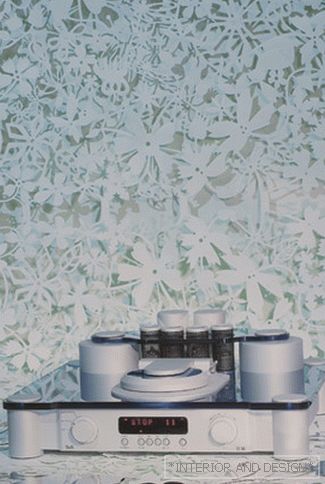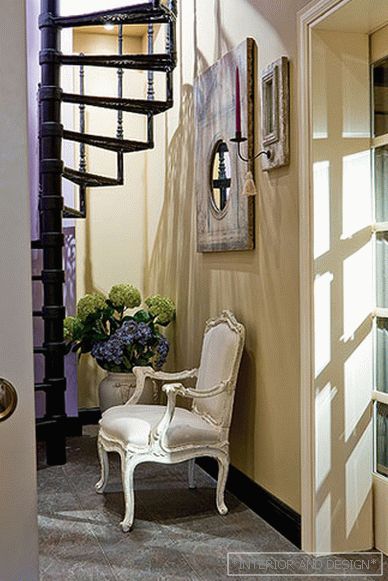Shiro Kuramata (1934-1991) is one of the few designers of the 20th century, along with Carlo Mollino, Eileen Gray and Jean Prouve, whose furniture is in demand by collectors around the world. Since the late 1990s, the most rare items Curamata cost five to six-digit sums. At the request of interior.ru gallery owner Alina Kovaleva tells about the “headliner” of the auctions of Shiro Kuramata.
Related: Denis Milovanov and Russian Painting
“The master from the country of“ elusive beauty ”Shiro Kuramata, whose work in all senses is very“ Japanese ”is one of the most influential designers of the twentieth century. His things are refined, ironic, multi-valued, minimalist and at the same time complex.
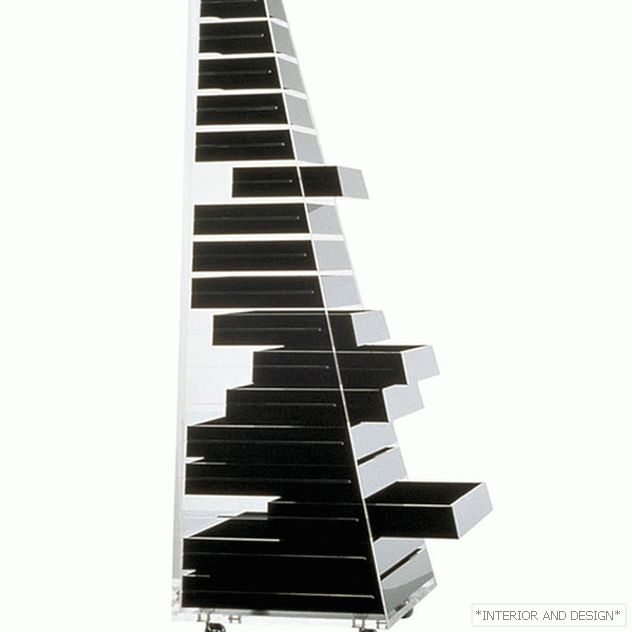 Vertical Pyramid chest of drawers. 1968. Launches Cappellini.
Vertical Pyramid chest of drawers. 1968. Launches Cappellini. Protégé of Issey Miyake, Ettore Sottsass friend and John Pawson (which is this friendship helped to become an architect), a member of the Milan group "Memphis", Kuramata belongs to the generation of such talents as Tadao Ando, Akira Kurosawa, Arata Isozaki, Rei Kawakubo, Takada Kenzo, Yohji Yamamoto. All of them were born shortly before the beginning of the Second World War and grew up under the authority of an authoritarian dictatorship, which demanded obedience and conformity. Their generation was the first to have the opportunity to speak freely.
 Bar in Kyoto. 1988
Bar in Kyoto. 1988 Yoshiharu Kuramata Yoshihiro Kiyoshi was born in 1934 in Tokyo. In the early 1950s, he studied at the woodworking department at the Tokyo Polytechnic Institute, worked in furniture manufacturing, and later graduated from the Kuwasawa School of Design with a degree in interior design. Formation of Kuramaty as a professional coincided with the industrial revolution in Japan, when the traditional Japanese way of life began to give way to Western modernism. Kuramata began with window dressing, and in 1965, he opened his Tokyo design bureau. The interior, decor and furniture attracted him more than architecture. Kuramata invented objects and designed designs for Issei Miyake boutiques in Paris, New York and Tokyo, created interiors for more than 300 bars and restaurants, most of which, unfortunately, no longer exist.
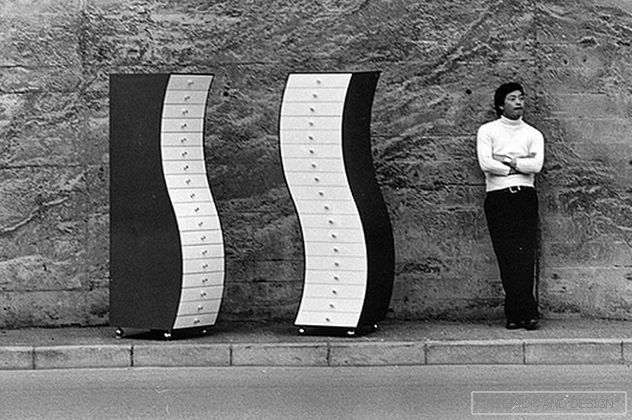 Drawer in an Irregular Form, 1977.
Drawer in an Irregular Form, 1977. He became known in the 1970s, thanks to the "wavy" high dressers. Drawer in an Irregular Form (1977). Storage systems and drawers are a typical attribute of Japanese interior culture, in which there is nothing superfluous, and a small space is used as efficiently as possible.
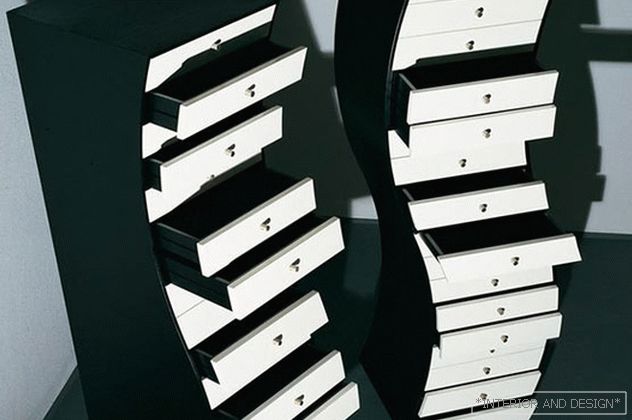 Drawer in an Irregular Form, 1977.
Drawer in an Irregular Form, 1977. European dealer Kuramata opened the London dealer and designer Zeev Aram: in 1981, in his showroom, he exhibited 19 works of interesting Japanese. During this period, Kuramata creates armchairs made of metal mesh and acrylic - sensational samples of postmodern design. At the end of the 1980s, a friend and a person of commensurate proportions Ettore Sottsass invites Kuramata to work for the Memphis group, an association of radical design, which, by the way, in addition to well-known European designers, included other Japanese. The most recognizable works of Kuramata of that period are concrete objects with colored glass inserts, as well as a strange, chair-like, Ritz writing desk. In 1988, Kuramata moved to Paris, where he opened his office in the rue Royal. In 1990, a year before his death, Kuramata was honored with the French Order of the Arts and elegant literature.
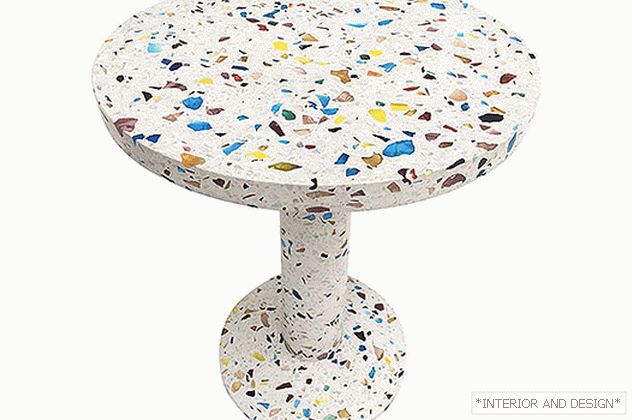 Table Kyoto. Memphis. 1980s. Terracco.
Table Kyoto. Memphis. 1980s. Terracco. The victory over gravity, the "dematerialization" of the object is one of the main meanings of the creative search for Kuramata. Such is the choice of materials: glass, metal mesh, clear acrylic. In each thing - the theme of emptiness, so important in Japanese culture.
 Glass Chair, 1976.
Glass Chair, 1976. Glass Chair (1976) made of pure glass was used to wash the group De Stijl and Pete Mondrian. Functional prose with immaterial appearance - the chair is completely transparent, its parts are fastened with invisible glue.
Related: Glass gradient: Herman Ermich's chair (Germans Ermičs)
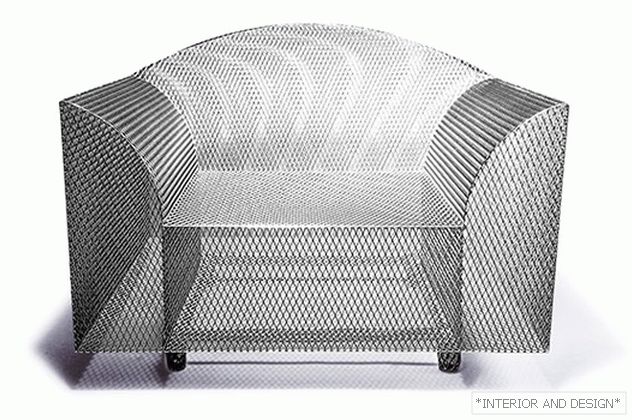 Armchair How High The Moon. 1986. Vitra re-publishes the chair today.
Armchair How High The Moon. 1986. Vitra re-publishes the chair today. One of the most recognizable examples of Curamata art is the chair How High The Moon (1986). The name "How High the Moon" originated from Duke Ellington's song. Moonlight, flicker, inaccessibility. From metal, material ordinary and heavy, Kuramata creates a weightless canvas - the chair-sculpture levitates in space.
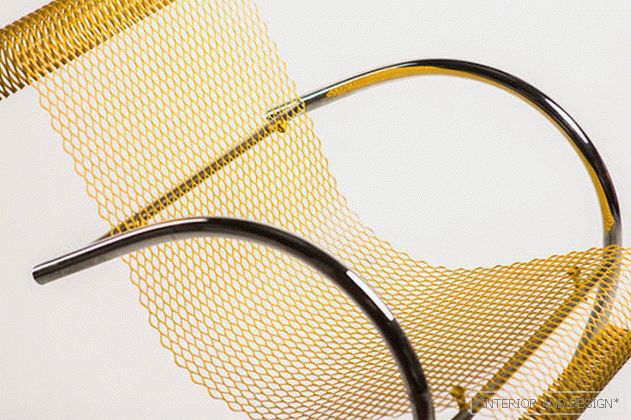 Chair Sing Sing Sing, published by XO. 1986. Steel, metal mesh. Gallery "Rosewood."
Chair Sing Sing Sing, published by XO. 1986. Steel, metal mesh. Gallery "Rosewood." 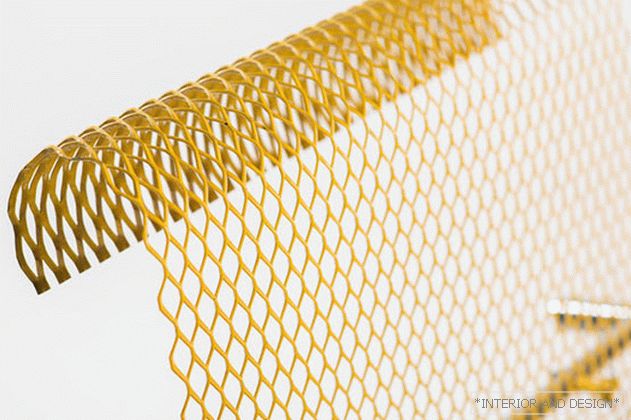 Chair Sing Sing Sing, published by XO. 1986. Steel, metal mesh. Gallery "Rosewood."
Chair Sing Sing Sing, published by XO. 1986. Steel, metal mesh. Gallery "Rosewood." 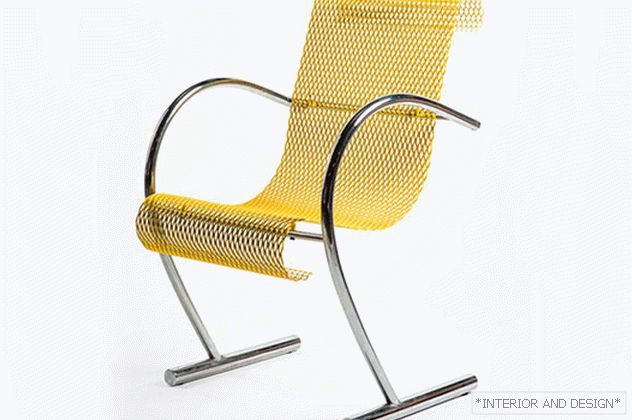 Chair Sing Sing Sing, published by XO. 1986. Steel, metal mesh. Gallery "Rosewood."
Chair Sing Sing Sing, published by XO. 1986. Steel, metal mesh. Gallery "Rosewood."  Chair Sing Sing Sing, published by XO. 1986. Steel, metal mesh. Gallery "Rosewood."
Chair Sing Sing Sing, published by XO. 1986. Steel, metal mesh. Gallery "Rosewood." Another famous metal mesh item is the Sing Sing Sing chair (1985). Here the name may have a double meaning: the song of the same Ellington or the prison Sing-Sing, where the electric chair was first used: the ambiguity itself and the irony of postmodernism.
 Table for Tachibana restaurant in Tokyo. 1991. Unikat. Sold at Phillips for $ 80,500.
Table for Tachibana restaurant in Tokyo. 1991. Unikat. Sold at Phillips for $ 80,500. The last auction sale of Miss Blanche was held in May 2017 at the Philips auction, with a result of 206 thousand euros.
Later acrylic took the place of the most beloved and often used material Kuramata. The chair of Miss Blanche (1988), named after Blanche Dubois, the heroine of Tennessee Williams' The Tram of Desire, became cult. It is believed that the author "spied" the floral motif on the corsage of Vivien Leigh in the film adaptation of the play. Delicate and fragile flowers, beauty, frozen in timelessness.
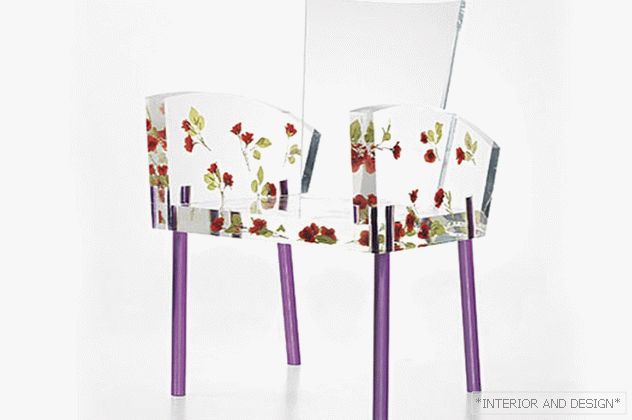 In the market of the chair Miss Blanche (1988) - a rarity. The original edition of eight extended to 56 pieces, according to the number of years Kuramaty lived.
In the market of the chair Miss Blanche (1988) - a rarity. The original edition of eight extended to 56 pieces, according to the number of years Kuramaty lived. Design items of Shiro Kuramata are in the permanent collections of the Pompidou Center, MoMA in New York and the Museum of Modern Art in Kyoto, the Victoria and Albert Museum, and others.
One of the largest researchers of design, director of the Design Museum in London, Deyan Sudjic writes that, despite the habit to consider Kuramata a minimalist, he could work well with rich color, both decorative and figurative elements. He was looking for ways to create an impression of tension between the object and the space, to get away from the materiality of the thing - and here any means were used.
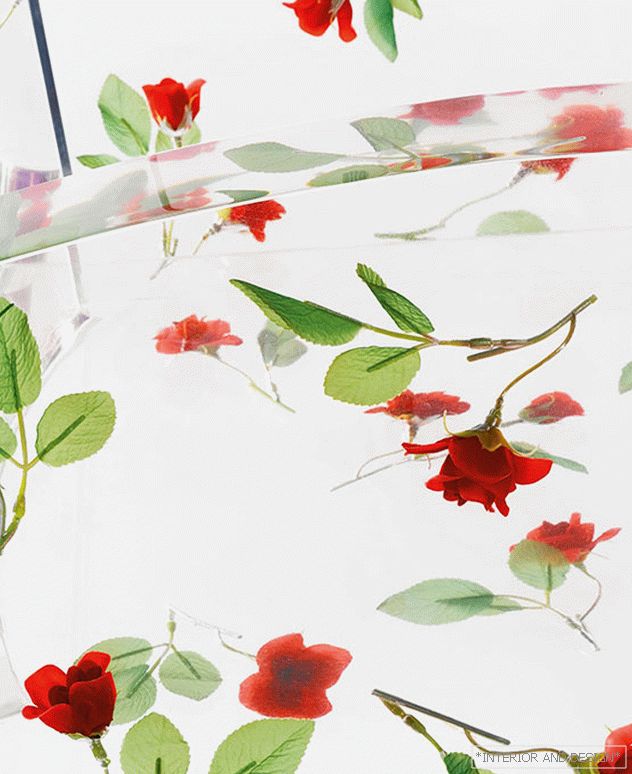 For the chair Miss Blanche, Kuramata initially wanted to use live roses. Then there was an experiment with high-quality artificial flowers. As a result, the cheapest plastic was immersed in hot acrylic.
For the chair Miss Blanche, Kuramata initially wanted to use live roses. Then there was an experiment with high-quality artificial flowers. As a result, the cheapest plastic was immersed in hot acrylic. Very scrupulous, Shirou always demanded a perfect result from his masters. He said that in the era of flights to the moon, nothing is impossible. For example, to create a chair from acrylic needed a clear calculation of the components for the hardening of the mass. At the same time, separate efforts were worth achieving material transparency. Kuramata loved experimenting. Once he wrapped a classic bentwood chair with wire and set it on fire ... Martin Baas then probably went to kindergarten.
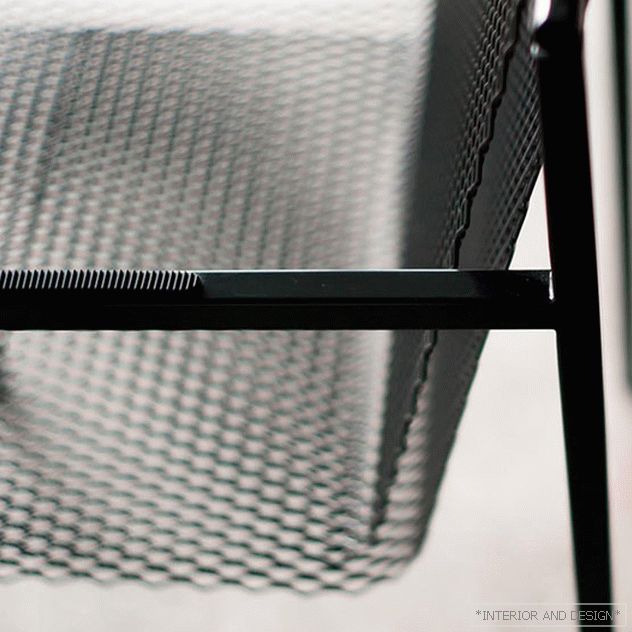 Fragment of a chair for Pastoe. 1985.
Fragment of a chair for Pastoe. 1985. Shiro Kuramata was a genius. For fans of esotericism, his palms will be revealing: no one has such clearly pronounced “four-fingered” lines. He could afford and shocking. However, in the same group Memphis Kuramata was more restrained than the rest, but no less noticeable from this. Just like George Harrison in the Beatles group. ”
From November 16 to January 15 in the gallery "Rosewood" Alina Kovaleva will show "Counterdesign: 70s, 80s": an exhibition of things Ettore Sottsass, Mikel de Lucca Latitude squad.

